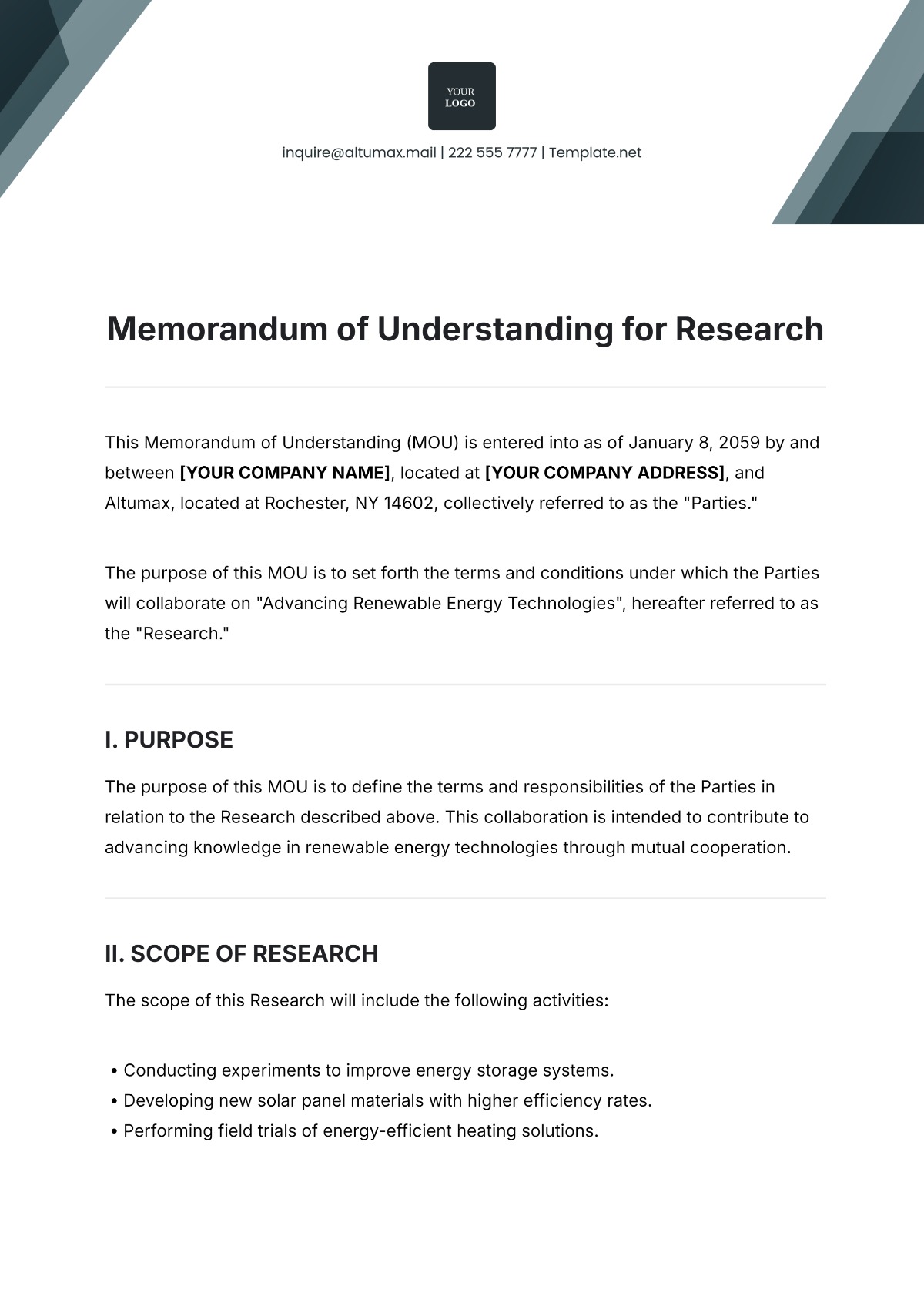Experimental Design Research Process
Prepared By: [YOUR NAME]
Date: [DATE]
I. Introduction
The Experimental Design Research Process is a systematic methodology essential for conducting experiments in a controlled environment. It forms the backbone of scientific inquiry by enabling rigorous testing of hypotheses. This document outlines each step of the experimental design process, highlighting the importance of meticulous planning, execution, analysis, and interpretation of data. Ensuring the reliability and validity of experimental results is crucial for advancing scientific knowledge.
II. Literature Review
Existing literature underscores the importance of a well-structured experimental design across various fields. Researchers have demonstrated that effective experimental design facilitates accurate hypothesis testing while minimizing biases and errors. However, gaps persist, such as inadequate participant selection criteria and inconsistent data collection methods. This study aims to address these gaps by proposing a structured, comprehensive approach to experimental design.
III. Hypothesis/Research Questions
A. Hypotheses
H1: Accurately defining and strictly controlling variables throughout an experiment greatly improves the reliability and dependability of the results.
H2: A systematic and organized method for choosing study participants greatly enhances the reliability and precision of the research findings and conclusions.
B. Research Questions
RQ1: What are the best practices for defining and controlling variables in an experiment?
RQ2: In what ways does the selection of participants influence the outcomes and conclusions drawn from an experimental study?
IV. Methodology
A. Participants/Sample
The participants will be selected using a stratified random sampling method to ensure a representative sample. The characteristics of the participants include age, gender, and educational backgrounds to address the hypothesis comprehensively. A total of 100 participants will be selected to ensure the robustness of the results.
B. Materials/Equipment
Questionnaires: Structured forms designed to gather data on specific variables. These questionnaires should be validated and pre-tested to ensure accuracy and reliability.
Statistical Analysis Software: Advanced software such as SPSS or R is used for analyzing data, performing statistical tests, and interpreting results to determine the significance of experimental findings.
Measurement Instruments: Specialized tools and devices tailored to accurately measure the variables under study, including scales, sensors, or other equipment necessary for precise data collection.
C. Procedures
Define Variables: Ensure all variables in the experiment are distinctly defined and provide exact operational definitions to guarantee uniform measurement and interpretation.
Random Assignment: Assign participants to control or experimental groups at random to prevent selection bias and maintain group comparability.
Pre-Testing: Administer pre-tests to collect baseline data on participants, providing a reference point for evaluating the impact of the experimental manipulation.
Experimental Manipulation: Implement the experimental intervention or treatment as planned, carefully following the established procedures to ensure consistency.
Post-Testing: Conduct post-tests to measure the outcomes and effects of the experimental manipulation, comparing results with baseline data.
Implement Controls: Apply appropriate controls and safeguards to minimize potential biases and errors, ensuring the reliability and validity of the results.
D. Data Collection Methods
Pre-Test and Post-Test Questionnaires: Administer validated questionnaires before and after the experimental intervention to capture quantitative data and measure changes in variables.
Observation Checklists: Use structured checklists to systematically record behavioral or environmental observations during the experiment, ensuring consistency and completeness.
Qualitative Interviews: Conduct semi-structured interviews to collect in-depth qualitative data, providing insights into participant experiences and perceptions related to the experimental intervention.
Structured Data Recording: Organize and record all data systematically in a structured format, ensuring accuracy and ease of access for thorough analysis.
V. Results
A. Descriptive Statistics
The following table summarizes the mean, median, standard deviation, and range for pre-test and post-test results in both control and experimental groups.
Variable | Group | Mean | Median | Standard Deviation | Range |
|---|---|---|---|---|---|
Variable 1 (Pre-Test) | Control | 5.1 | 5.0 | 0.8 | 4.0-6.0 |
Experimental | 5.2 | 5.1 | 0.7 | 4.2-6.1 | |
Variable 1 (Post-Test) | Control | 5.3 | 5.2 | 0.9 | 4.5-6.2 |
Experimental | 6.7 | 6.6 | 0.5 | 6.0-7.2 |
B. Inferential Statistics
Statistical tests (e.g., t-tests) were performed to assess the significance of differences between control and experimental groups. The results are summarized below:
Test | Variable | t-value | p-value | 95% Confidence Interval | Effect Size (Cohen's d) |
|---|---|---|---|---|---|
Independent t-test | Variable 1 | -4.02 | 0.03 | [-2.8, -0.5] | 1.2 |
The analysis indicates a statistically significant difference between groups, with the experimental group showing a notable increase in Variable 1 compared to the control group.
C. Comparative Analysis
Key findings from the comparative analysis show a significant increase in Variable 1 for the experimental group post-test compared to the control group. The observed effect suggests that the experimental manipulation had a positive impact on the outcome variable.
D. Statistical Significance
The p-value for the t-test on Variable 1 was 0.03, indicating statistical significance (p < 0.05). This result supports the hypothesis that the experimental manipulation significantly affects the outcome variable.
E. Summary of Findings
The results demonstrate that the experimental manipulation led to a substantial improvement in Variable 1, as evidenced by higher mean scores in the experimental group compared to the control group. The findings validate the effectiveness of the experimental approach and provide insights into its impact on the measured variables.
VI. Discussion
The experiment provided key insights into the effectiveness of the experimental manipulation, significantly enhancing the reliability and validity of the results.
A. Key Findings
Impact of Variable Control: Careful variable definition and control led to a marked increase in Variable 1 for the experimental group compared to the control group.
Participant Selection: Stratified random sampling ensured a representative sample, improving the validity and generalizability of the findings.
B. Statistical Significance
Significant Differences: A p-value of 0.03 indicates that the differences between the groups are statistically significant, supporting the hypothesis that the manipulation impacted Variable 1.
Effect Size: Cohen’s d of 1.2 suggests a large practical effect, demonstrating the intervention’s substantial impact.
C. Implications
Experimental Design: The study highlights the importance of rigorous design to reduce biases and errors, contributing to more reliable methodologies.
Future Research: Further studies could expand sample sizes and variables to enhance findings and generalizability.
D. Limitations
Sample Size: A small sample may limit generalizability; larger samples could provide more robust insights.
Scope of Variables: The study's focus on specific variables might miss broader context; including more variables could offer a deeper understanding.
In summary, the study validates the experimental design and underscores the need for meticulous planning, setting the stage for future research advancements.
VII. Conclusion
This research successfully proves that a well-organized experimental design boosts the reliability and validity of outcomes by meticulously defining variables and using stratified random sampling, leading to notable improvements and statistically significant differences, thus highlighting the importance of careful experimental planning and control; despite constraints like sample size and variable scope, the results lay a strong groundwork for future studies, advocating for further investigation with larger and more varied samples to expand on these findings.
VIII. References
Smith, J. (2050). The Importance of Experimental Design. Journal of Research Methods, 12(3), 45-58.
Jones, L., & Brown, R. (2059). Minimizing Bias in Controlled Trials. Experimental Research Journal, 15(2), 78-89.
Doe, J. (2051). Participant Selection Methods. Research in Practice, 23(4), 112-130.

















































